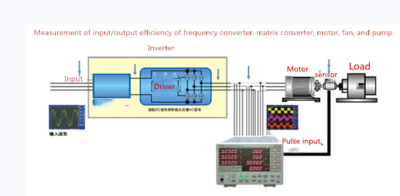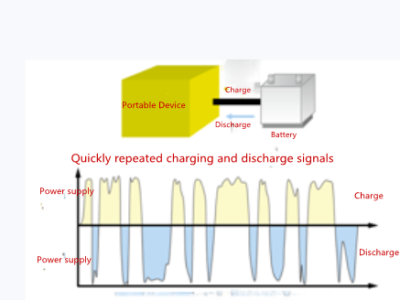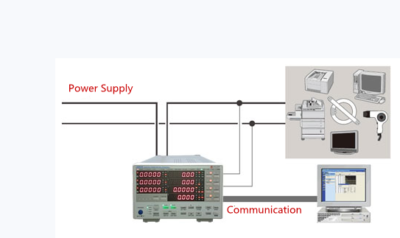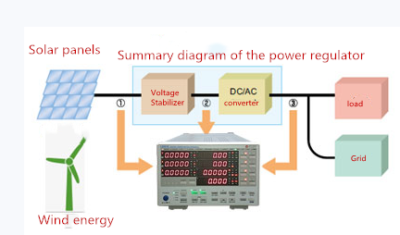Product No: LS8930
Specification:
| Input Type | Voltage |
| Floating input, resistance division method | |
| Current | |
| Floating input, diversion method | |
| Measuring range | LS8930 Voltage (1000V): |
| Voltage: 1000V, 600V, 300V, 150V, 60V, 30V | |
| Current 50A | |
| Current: 50A, 20A, 10A, 5A, 2A, 1A | |
| Current 5A: | |
| Current: 5A, 2A, 1A, 0.5A, 0.2A, 0.1A | |
| Input resistance | The voltage input impedance is about 2MΩ, and the current input impedance is about 4mΩ at low range. The input impedance of the external sensor signal input terminal changes according to the input voltage, about 100kΩ at 10V and about 20kΩ at 2V. |
| Circuit filter | 500Hz, 5500Hz hardware filter. |
| Frequency filter | 500Hz, 5500Hz hardware filter. |
| AD converter | The sampling period is about 10μS (speed 100k/S) |
| Accuracy: 16 digits | |
| Simultaneous conversion of voltage and current | |
| Zero calibration method | The zero point is calibrated when the measurement mode is changed or each time the measurement mode is changed. |
| Range switching | You can set the range according to the input unit |
| Unified range setting for all units. | |
| Automatic range function | With automatic range function |
| Testable items | Voltage: |
| Urms: True RMS value Umn: Rectified mean value calibrated to the RMS value | |
| Udc: Simple mean value Urmn: Rectified mean value | |
| Uac: AC component | |
| Current: | |
| Irms:True RMS value Imn: Rectified mean value calibrated to the RMS value | |
| Idc: Simple mean value Irmn: Rectified mean value | |
| Iac: AC component | |
| Active power, apparent power, reactive power, power factor, phase difference, frequency, U+pk, U-pk, I+pk, I-pk, P+pk, P-pk, crest factor, WP, WP+, WP-, q, q+, q-. | |
| Anti-interference | Impact of anti-interference environment: Measurement input: within ± 20%of the range |
| Working Power supply | AC 85V~265V 50/60Hz |
| working Environmental | Temperature: (0~40)℃; Humidity: (20%~75%)RH; Air Pressure: (86~106)kPa |
| Power consumption | <10VA |
| Dimensions | Max. size is width*height*deep (223.5*151.5*384mm). |
Accuracy:
| Parameter | Range | Accuracy | Remark | |
| Voltage(V) | Crest factor CF=3: 1000V | DC±(reading0.1% +range 0.1% ) | Overload | |
| Crest factor CF=6: 500V | 0.5 Hz ≤ f< 45 Hz ±(reading0.1% +range 0.1% ) | 110% | ||
| 45 Hz ≤ f ≤ 66 Hz ±(reading0.1% +range 0.05% ) | ||||
| 66 Hz < f ≤ 1 kHz ±(reading0.1% +range 0.1% ) | ||||
| 1 kHz < f ≤ 2 kHz ±(reading0.1% +range 0.2% ) | ||||
| 10 kHz < f ≤ 100 kHz ±(reading0.5% +range 0.5 % ) | ||||
| Current (A) | Crest factor CF=3: 50A | ±[reading{0.04*(f-10)}%] | ||
| (50A only input current CF≤1.5) | ||||
| Crest factor CF=6: 25A | ||||
| (50A only input current CF≤1.5) | ||||
| Active power | U*I | DC±(reading0.1% +range 0.1% ) | PF=1.0 | |
| 0.5 Hz ≤ f< 45 Hz ±(reading0.3% +range 0.05% ) | ||||
| 45 Hz ≤ f ≤ 66 Hz ±(reading0.1% +range 0.1 % ) | ||||
| 66 Hz < f ≤ 1 kHz ±(reading0.2% +range 0.2 % ) | ||||
| 1 kHz < f ≤ 2 kHz ±(reading0.1% +range 0.3 % ) | ||||
| ±[reading{0.067*(f-1)}%] | ||||
| 10 kHz < f ≤ 100 kHz ±(reading0.5% +range 0.5 % ) | ||||
| ±[reading{0.09*(f-10)}%] | ||||
| Power factor | 0.1~1 | ±11 r factorng0.cosØ-cos{Ø+sin-1 | ||
| Frequency (Hz) | 0.5~100kHz | 0.1%* reading,when value >0.1*present range | ||
| Electric energy accumulation | 0~999999 MWh /0~-99999 MWh | DC±(reading0.1% +range 0.2% ) | ||
| 0.5 Hz ≤ f< 45 Hz ±(reading0.3% +range 0.2% ) | ||||
| 45 Hz ≤ f ≤ 66 Hz ±(reading0.1% +range 0.1 % ) | ||||
| 66 Hz < f ≤ 1 kHz ±(reading0.2% +range 0.2 % ) | ||||
| 1 kHz < f ≤ 2 kHz ±(reading0.1% +range 0.3 % ) | ||||
| ±[reading{0.067*(f-1)}%] | ||||
| 10 kHz < f ≤ 100 kHz ±(reading0.5% +range 0.5 % ) | ||||
| ±[reading{0.09*(f-10)}%] | ||||
| Ah accumulation | 0~999999 MAh /0~-99999 MAh | DC±(reading0.1% +range 0.2% ) | ||
| 0.5 Hz ≤ f< 45 Hz ±(reading0.1% +range 0.2% ) | ||||
| 45 Hz ≤ f ≤ 66 Hz ±(reading0.1% +range 0.1 % ) | ||||
| 66 Hz < f ≤ 1 kHz ±(reading0.1% +range 0.2 % ) | ||||
| 1 kHz < f ≤ 2 kHz ±(reading0.1% +range 0.3 % ) | ||||
| ±[reading(0.07*F) %+range 0.3 %] | ||||
| 10 kHz < f ≤ 100 kHz ±(reading0.5% +range 0.5 % ) | ||||
| ±[reading{0.04*(f-10)}%] | ||||
| Energy timing | 99999h | ± 2 seconds/hour | ||
| Harmonic | 1~50 order | Fundamental wave frequency | Maximum order | B grade |
| 10Hz~65Hz | 50 | |||
| 65Hz~100Hz | 32 | |||
| 100Hz~200Hz | 16 | |||
| 200Hz~400Hz | 8 | |||
Application:
1. Motor and inverter industry
In recent years, with the increasing demand for energy efficiency, there has been a growing need for high-precision measurement of motor/inverter efficiency. LS8930 can provide 3 voltage and 3 current inputs to accurately test the performance of the motor at the back end of the inverter. It can also be used for high-precision measurement in the efficiency evaluation of single-phase input/three-phase output inverters using specified line systems. Additionally, with the optional motor expansion accessory, it can observe voltage, current, and power changes, as well as monitor speed and torque variations, calculate and display mechanical power and overall efficiency.

Motor and inverter industry
2. Battery industry
• High -precision measurement, measuring battery filling (Ah/Wh)
• Test/battery charging and discharge of car batteries or DC driver devices
• It can directly measure high currents up to 40A without the need for external current sensors, making it suitable for testing automotive DC drive systems. This provides users with an economical and accurate evaluation method.
• Measurement of battery charging and discharging energy (+/-Wh, +/-Ah) is performed, capturing instantaneous positive and negative values at a high sampling rate of approximately 100K/s. Integration operations are then conducted separately. This not only presents the true characteristics of the battery but also assists users in cost reduction and improving the efficiency of inverter/motor testing and maintenance.
• For portable devices, electric bicycles, and other battery-powered products, engineers often need to perform short-term charge and discharge tests under real working conditions. Due to the adoption of a digital sampling system in LS8930, it enables continuous integration of rapidly changing charge and discharge currents and powers. This is highly effective in utilizing ampere-hour and watt-hour calculations to evaluate battery life.

Power Supply
3. Power industry
LS8930 is particularly suitable for power consumption measurement of switch-mode power supplies and variable frequency home appliances. An increasing number of electronic products and household appliances on the market adopt switch-mode power supplies or variable frequency technology, which not only saves energy but also introduces waveform distortion to the product’s signal. These distorted waveforms are non-sinusoidal signals, such as pulse waves, triangular waves, square waves, trapezoidal waves, pulse trains, etc., containing rich high-frequency harmonic components. Ordinary power meters, limited by their sampling rate and bandwidth, cannot accurately measure high-frequency components, resulting in significant discrepancies between their measurements and the true values.
LS8930 has the following advantages for testing variable frequency devices and switch-mode power supplies:
• It features a high sampling rate, enabling the measurement of rich high-order harmonic components in distorted waveforms without any energy loss.
• The high bandwidth power meter can filter out high-order harmonics in the signal, ensuring precise measurement. It also ensures that high-frequency components in the signal are not filtered out by the analog front-end circuit, thereby preventing energy loss. It fully satisfies the power consumption measurement requirements of new technology products such as variable frequency home appliances and switch-mode power supplies.
4. Home Appliance Industry: Measurement of Standby Power and Operating Power Consumption of Household Appliances
Measurement of Standby Power and Operating Power Consumption of Household Appliances in compliance with international standards (IEC62301, Energy Star, SPECpower) in the fields of home appliances, digital devices, LED lamps, LED drivers, mobile phone chargers, etc. The LS8930 Power Analyzer offers multiple voltage and current ranges, as well as various specifications, to meet the energy consumption analysis requirements of household appliance products in standby mode.
The testing of high-current devices such as induction cookers and electric water heaters can directly measure large currents of up to 40Arms without the need for an external current sensor. The automatic range switching function in integration mode not only provides users with more accurate measurements but also reduces investment costs.

Home Appliance Industry
5. Renewable energy testing industry: Wind power generation and solar energy inverter systems
High precision of 0.2%, frequency testing as low as 0.5Hz, simultaneous sampling of 3 channels, 50 harmonics, and the ability to add interharmonic functionality. It can meet the requirements of wind power generation equipment and the new energy field to simultaneously measure the input and output of the inverter, and directly calculate and display the efficiency of the inverter.

Renewable energy testing industry